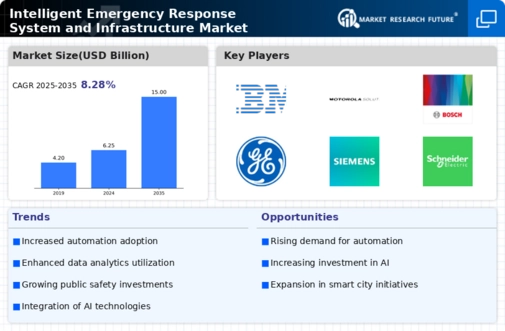Government Initiatives and Funding
Government initiatives and funding play a pivotal role in shaping the Intelligent Emergency Response System and Infrastructure Market. Many governments are prioritizing the development of smart emergency response systems as part of their public safety strategies. This includes allocating budgets for research and development, as well as grants for local agencies to implement advanced technologies. Recent reports indicate that government spending in this sector is projected to grow significantly, with some regions earmarking millions for the enhancement of emergency response capabilities. Such financial support is likely to stimulate innovation and adoption of intelligent systems.
Rising Demand for Enhanced Public Safety
The increasing need for improved public safety measures is a primary driver for the Intelligent Emergency Response System and Infrastructure Market. As urban populations grow, the complexity of emergency situations escalates, necessitating advanced systems that can respond effectively. According to recent data, cities are investing heavily in smart technologies to enhance their emergency response capabilities. This trend is expected to continue, with projections indicating that the market could reach a valuation of several billion dollars by the end of the decade. The integration of intelligent systems allows for quicker decision-making and resource allocation, ultimately leading to better outcomes during emergencies.
Growing Awareness of Disaster Preparedness
The growing awareness of disaster preparedness among communities is driving the Intelligent Emergency Response System and Infrastructure Market. As natural disasters become more frequent and severe, there is an increasing emphasis on readiness and resilience. Educational campaigns and community training programs are being implemented to inform the public about emergency protocols and the importance of intelligent systems in disaster response. This heightened awareness is expected to lead to greater demand for advanced emergency response solutions, as communities seek to enhance their preparedness and response capabilities.
Technological Advancements in Communication Systems
Technological advancements in communication systems are significantly influencing the Intelligent Emergency Response System and Infrastructure Market. Enhanced communication technologies, such as 5G networks, enable real-time data sharing and coordination among emergency responders. This capability is crucial for effective incident management and resource deployment. Recent statistics suggest that the adoption of these technologies could lead to a reduction in response times by up to 30%. As municipalities and organizations recognize the benefits of these advancements, investments in communication infrastructure are likely to increase, further propelling market growth.
Integration of Data Analytics in Emergency Management
The integration of data analytics in emergency management is emerging as a crucial driver for the Intelligent Emergency Response System and Infrastructure Market. By leveraging big data, emergency services can analyze patterns and predict potential incidents, allowing for proactive measures. This analytical approach enhances situational awareness and improves resource allocation during emergencies. Recent findings suggest that organizations utilizing data analytics can achieve a 25% increase in operational efficiency. As the importance of data-driven decision-making becomes more recognized, investments in analytics tools and technologies are likely to rise, further fueling market growth.


















Leave a Comment